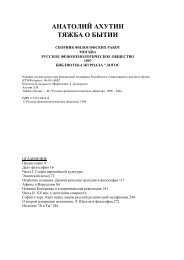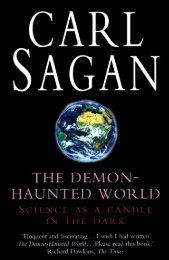- Page 1:
CAPITALISM’S ACHILLES HEEL Dirty
- Page 4 and 5:
concerted actions to reduce opportu
- Page 6 and 7:
Copyright © 2005 by Raymond W. Bak
- Page 9 and 10:
CONTENTS Prologue 1 CHAPTER 1 Globa
- Page 11:
CHAPTER 10 Philosophy Becomes Cultu
- Page 14 and 15:
2 CAPITALISM’S ACHILLES HEEL to a
- Page 16 and 17:
4 CAPITALISM’S ACHILLES HEEL In a
- Page 18 and 19:
6 CAPITALISM’S ACHILLES HEEL on t
- Page 20 and 21:
8 CAPITALISM’S ACHILLES HEEL Over
- Page 23 and 24:
“ CHAPTER 1 GLOBAL CAPITALISM: SA
- Page 25 and 26:
Global Capitalism: Savior or Predat
- Page 27 and 28:
Global Capitalism: Savior or Predat
- Page 29 and 30:
Global Capitalism: Savior or Predat
- Page 31:
Global Capitalism: Savior or Predat
- Page 34 and 35:
22 CAPITALISM’S ACHILLES HEEL he
- Page 36 and 37:
24 CAPITALISM’S ACHILLES HEEL sec
- Page 38 and 39:
26 CAPITALISM’S ACHILLES HEEL Uni
- Page 40 and 41:
28 CAPITALISM’S ACHILLES HEEL aff
- Page 42 and 43:
30 CAPITALISM’S ACHILLES HEEL tra
- Page 44 and 45:
32 CAPITALISM’S ACHILLES HEEL Fra
- Page 46 and 47:
34 CAPITALISM’S ACHILLES HEEL own
- Page 48 and 49:
36 CAPITALISM’S ACHILLES HEEL The
- Page 50 and 51:
38 CAPITALISM’S ACHILLES HEEL nei
- Page 52 and 53:
40 CAPITALISM’S ACHILLES HEEL Why
- Page 54 and 55:
42 CAPITALISM’S ACHILLES HEEL Dru
- Page 56 and 57: 44 CAPITALISM’S ACHILLES HEEL qui
- Page 58 and 59: 46 CAPITALISM’S ACHILLES HEEL dea
- Page 60 and 61: CHAPTER 3 DIRTY MONEY AT WORK HOW D
- Page 62 and 63: 50 CAPITALISM’S ACHILLES HEEL ter
- Page 64 and 65: 52 CAPITALISM’S ACHILLES HEEL TAB
- Page 66 and 67: 54 CAPITALISM’S ACHILLES HEEL Tha
- Page 68 and 69: 56 CAPITALISM’S ACHILLES HEEL Oto
- Page 70 and 71: 58 CAPITALISM’S ACHILLES HEEL whi
- Page 72 and 73: 60 CAPITALISM’S ACHILLES HEEL pay
- Page 74 and 75: 62 CAPITALISM’S ACHILLES HEEL imp
- Page 76 and 77: 64 CAPITALISM’S ACHILLES HEEL lod
- Page 78 and 79: 66 CAPITALISM’S ACHILLES HEEL tax
- Page 80 and 81: 68 CAPITALISM’S ACHILLES HEEL arm
- Page 82 and 83: 70 CAPITALISM’S ACHILLES HEEL But
- Page 84 and 85: 72 CAPITALISM’S ACHILLES HEEL wai
- Page 86 and 87: 74 CAPITALISM’S ACHILLES HEEL inv
- Page 88 and 89: 76 CAPITALISM’S ACHILLES HEEL TAB
- Page 90 and 91: 78 CAPITALISM’S ACHILLES HEEL 197
- Page 92 and 93: 80 CAPITALISM’S ACHILLES HEEL Cit
- Page 94 and 95: 82 CAPITALISM’S ACHILLES HEEL the
- Page 96 and 97: 84 CAPITALISM’S ACHILLES HEEL ass
- Page 98 and 99: 86 CAPITALISM’S ACHILLES HEEL TAB
- Page 100 and 101: 88 CAPITALISM’S ACHILLES HEEL THE
- Page 102 and 103: 90 CAPITALISM’S ACHILLES HEEL est
- Page 104 and 105: 92 CAPITALISM’S ACHILLES HEEL the
- Page 108 and 109: 96 CAPITALISM’S ACHILLES HEEL car
- Page 110 and 111: 98 CAPITALISM’S ACHILLES HEEL or
- Page 112 and 113: 100 CAPITALISM’S ACHILLES HEEL do
- Page 114 and 115: 102 CAPITALISM’S ACHILLES HEEL TA
- Page 116 and 117: 104 CAPITALISM’S ACHILLES HEEL it
- Page 118 and 119: 106 CAPITALISM’S ACHILLES HEEL TA
- Page 120 and 121: 108 CAPITALISM’S ACHILLES HEEL TA
- Page 122 and 123: 110 CAPITALISM’S ACHILLES HEEL pl
- Page 124 and 125: 112 CAPITALISM’S ACHILLES HEEL Mi
- Page 126 and 127: 114 CAPITALISM’S ACHILLES HEEL be
- Page 128 and 129: 116 CAPITALISM’S ACHILLES HEEL ya
- Page 130 and 131: 118 CAPITALISM’S ACHILLES HEEL it
- Page 132 and 133: 120 CAPITALISM’S ACHILLES HEEL Un
- Page 134 and 135: 122 CAPITALISM’S ACHILLES HEEL TA
- Page 136 and 137: 124 CAPITALISM’S ACHILLES HEEL po
- Page 138 and 139: 126 CAPITALISM’S ACHILLES HEEL fo
- Page 140 and 141: 128 CAPITALISM’S ACHILLES HEEL fa
- Page 142 and 143: 130 CAPITALISM’S ACHILLES HEEL th
- Page 144 and 145: 132 CAPITALISM’S ACHILLES HEEL Af
- Page 146 and 147: 134 CAPITALISM’S ACHILLES HEEL ti
- Page 148 and 149: 136 CAPITALISM’S ACHILLES HEEL ta
- Page 150 and 151: 138 CAPITALISM’S ACHILLES HEEL Yo
- Page 152 and 153: 140 CAPITALISM’S ACHILLES HEEL Mo
- Page 154 and 155: 142 CAPITALISM’S ACHILLES HEEL pa
- Page 156 and 157:
144 CAPITALISM’S ACHILLES HEEL by
- Page 158 and 159:
146 CAPITALISM’S ACHILLES HEEL bu
- Page 160 and 161:
148 CAPITALISM’S ACHILLES HEEL SA
- Page 162 and 163:
150 CAPITALISM’S ACHILLES HEEL fa
- Page 164 and 165:
152 CAPITALISM’S ACHILLES HEEL in
- Page 166 and 167:
154 CAPITALISM’S ACHILLES HEEL of
- Page 168 and 169:
156 CAPITALISM’S ACHILLES HEEL be
- Page 170 and 171:
158 CAPITALISM’S ACHILLES HEEL Ru
- Page 172 and 173:
160 CAPITALISM’S ACHILLES HEEL Co
- Page 174 and 175:
“ CHAPTER 4 MAGNITUDES AND MISUND
- Page 176 and 177:
164 CAPITALISM’S ACHILLES HEEL TA
- Page 178 and 179:
166 CAPITALISM’S ACHILLES HEEL th
- Page 180 and 181:
168 CAPITALISM’S ACHILLES HEEL an
- Page 182 and 183:
170 CAPITALISM’S ACHILLES HEEL su
- Page 184 and 185:
172 CAPITALISM’S ACHILLES HEEL se
- Page 186 and 187:
174 CAPITALISM’S ACHILLES HEEL co
- Page 188 and 189:
176 CAPITALISM’S ACHILLES HEEL UN
- Page 190 and 191:
178 CAPITALISM’S ACHILLES HEEL 20
- Page 192 and 193:
180 CAPITALISM’S ACHILLES HEEL ba
- Page 194 and 195:
182 CAPITALISM’S ACHILLES HEEL
- Page 196 and 197:
184 CAPITALISM’S ACHILLES HEEL As
- Page 198 and 199:
186 CAPITALISM’S ACHILLES HEEL IL
- Page 200 and 201:
188 CAPITALISM’S ACHILLES HEEL TA
- Page 202 and 203:
190 CAPITALISM’S ACHILLES HEEL mo
- Page 204 and 205:
192 CAPITALISM’S ACHILLES HEEL Th
- Page 206 and 207:
194 CAPITALISM’S ACHILLES HEEL
- Page 208 and 209:
196 CAPITALISM’S ACHILLES HEEL Of
- Page 210 and 211:
198 CAPITALISM’S ACHILLES HEEL de
- Page 212 and 213:
200 CAPITALISM’S ACHILLES HEEL fr
- Page 214 and 215:
202 CAPITALISM’S ACHILLES HEEL We
- Page 216 and 217:
204 CAPITALISM’S ACHILLES HEEL St
- Page 218 and 219:
206 CAPITALISM’S ACHILLES HEEL If
- Page 220 and 221:
208 CAPITALISM’S ACHILLES HEEL ta
- Page 222 and 223:
CHAPTER 5 THE GLOBAL DIVIDE WRITING
- Page 224 and 225:
212 CAPITALISM’S ACHILLES HEEL th
- Page 226 and 227:
214 CAPITALISM’S ACHILLES HEEL FI
- Page 228 and 229:
216 CAPITALISM’S ACHILLES HEEL it
- Page 230 and 231:
218 CAPITALISM’S ACHILLES HEEL FI
- Page 232 and 233:
220 CAPITALISM’S ACHILLES HEEL FI
- Page 234 and 235:
222 CAPITALISM’S ACHILLES HEEL Re
- Page 236 and 237:
224 CAPITALISM’S ACHILLES HEEL 65
- Page 238 and 239:
226 CAPITALISM’S ACHILLES HEEL No
- Page 240 and 241:
228 CAPITALISM’S ACHILLES HEEL la
- Page 242 and 243:
230 CAPITALISM’S ACHILLES HEEL th
- Page 244 and 245:
232 CAPITALISM’S ACHILLES HEEL so
- Page 246 and 247:
234 CAPITALISM’S ACHILLES HEEL po
- Page 248 and 249:
236 CAPITALISM’S ACHILLES HEEL is
- Page 250 and 251:
238 CAPITALISM’S ACHILLES HEEL ma
- Page 252 and 253:
CHAPTER 6 “I DON’T UNDERSTAND
- Page 254 and 255:
242 CAPITALISM’S ACHILLES HEEL sh
- Page 256 and 257:
244 CAPITALISM’S ACHILLES HEEL Th
- Page 258 and 259:
246 CAPITALISM’S ACHILLES HEEL Me
- Page 260 and 261:
248 CAPITALISM’S ACHILLES HEEL si
- Page 262 and 263:
250 CAPITALISM’S ACHILLES HEEL Co
- Page 264 and 265:
252 CAPITALISM’S ACHILLES HEEL Fi
- Page 266 and 267:
254 CAPITALISM’S ACHILLES HEEL Th
- Page 268 and 269:
256 CAPITALISM’S ACHILLES HEEL di
- Page 270 and 271:
258 CAPITALISM’S ACHILLES HEEL Co
- Page 272 and 273:
260 CAPITALISM’S ACHILLES HEEL ti
- Page 274 and 275:
CHAPTER 7 IT’S THE 70 TO 90 PERCE
- Page 276 and 277:
264 CAPITALISM’S ACHILLES HEEL No
- Page 278 and 279:
266 CAPITALISM’S ACHILLES HEEL an
- Page 280 and 281:
268 CAPITALISM’S ACHILLES HEEL ga
- Page 282 and 283:
270 CAPITALISM’S ACHILLES HEEL Di
- Page 284 and 285:
272 CAPITALISM’S ACHILLES HEEL fo
- Page 286 and 287:
274 CAPITALISM’S ACHILLES HEEL Le
- Page 288 and 289:
276 CAPITALISM’S ACHILLES HEEL Me
- Page 291 and 292:
“ PART III DISUTILITY: BENTHAM KO
- Page 293 and 294:
Disutility: Bentham KOs Smith 281 t
- Page 295 and 296:
study and lecture, taking up in 175
- Page 297 and 298:
The Anguish of Adam Smith 285 of gr
- Page 299 and 300:
The Anguish of Adam Smith 287 Preva
- Page 301 and 302:
The Anguish of Adam Smith 289 Preva
- Page 303 and 304:
The Anguish of Adam Smith 291 Smith
- Page 305 and 306:
ing the joys of wealth to all. In t
- Page 307 and 308:
The Anguish of Adam Smith 295 paid
- Page 309 and 310:
seated concern for exemplary behavi
- Page 311 and 312:
The Anguish of Adam Smith 299 want
- Page 313 and 314:
ut, with growing passion for legal
- Page 315 and 316:
The Joys of Jeremy Bentham 303 fice
- Page 317 and 318:
view in 1824 as an outlet for their
- Page 319 and 320:
Bentham’s ideas were not all outl
- Page 321 and 322:
PROBLEMS The Joys of Jeremy Bentham
- Page 323 and 324:
The Joys of Jeremy Bentham 311 Jere
- Page 325 and 326:
ate homogeneity, and the lowest inc
- Page 327 and 328:
Philosophy Becomes Culture 315 intr
- Page 329 and 330:
Philosophy Becomes Culture 317 Desi
- Page 331 and 332:
Thus, from the late 1700s to the ea
- Page 333 and 334:
Philosophy Becomes Culture 321 War
- Page 335 and 336:
The point is much simpler. In the v
- Page 337 and 338:
dard model attempt to incorporate t
- Page 339 and 340:
tarianism, operating through tenets
- Page 341 and 342:
Philosophy Becomes Culture 329 enou
- Page 343:
Philosophy Becomes Culture 331 •
- Page 346 and 347:
334 CAPITALISM’S ACHILLES HEEL mo
- Page 348 and 349:
336 CAPITALISM’S ACHILLES HEEL th
- Page 350 and 351:
338 CAPITALISM’S ACHILLES HEEL di
- Page 352 and 353:
340 CAPITALISM’S ACHILLES HEEL An
- Page 354 and 355:
CHAPTER 12 SPREADING PROSPERITY RES
- Page 356 and 357:
344 CAPITALISM’S ACHILLES HEEL In
- Page 358 and 359:
346 CAPITALISM’S ACHILLES HEEL TO
- Page 360 and 361:
348 CAPITALISM’S ACHILLES HEEL So
- Page 362 and 363:
350 CAPITALISM’S ACHILLES HEEL If
- Page 364 and 365:
352 CAPITALISM’S ACHILLES HEEL ba
- Page 366 and 367:
354 CAPITALISM’S ACHILLES HEEL st
- Page 368 and 369:
356 CAPITALISM’S ACHILLES HEEL La
- Page 370 and 371:
358 CAPITALISM’S ACHILLES HEEL Al
- Page 372 and 373:
360 CAPITALISM’S ACHILLES HEEL ch
- Page 374 and 375:
362 CAPITALISM’S ACHILLES HEEL Ra
- Page 376 and 377:
364 CAPITALISM’S ACHILLES HEEL hi
- Page 378 and 379:
366 CAPITALISM’S ACHILLES HEEL Ho
- Page 380 and 381:
CHAPTER 13 RENEWING CAPITALISM SHOR
- Page 382 and 383:
370 CAPITALISM’S ACHILLES HEEL tr
- Page 384 and 385:
372 CAPITALISM’S ACHILLES HEEL Th
- Page 386 and 387:
374 CAPITALISM’S ACHILLES HEEL Tr
- Page 389 and 390:
ACKNOWLEDGMENTS JENNIFER NORDIN has
- Page 391 and 392:
Acknowledgments 379 helpful. E. J.
- Page 393:
Acknowledgments 381 I’m addressin
- Page 396 and 397:
384 NOTES 10. Harry Shutt, The Trou
- Page 398 and 399:
386 NOTES countries, can be exchang
- Page 400 and 401:
388 NOTES 14. U.S. Senate, Committe
- Page 402 and 403:
390 NOTES 51. Sultan Ahmed, “Reco
- Page 404 and 405:
392 NOTES 82. Gregg Zoroya, “Mili
- Page 406 and 407:
394 NOTES Transnational Crime and C
- Page 408 and 409:
396 NOTES 131. 2002 Human Rights Re
- Page 410 and 411:
398 NOTES 148. Susan Sachs, “Huss
- Page 412 and 413:
400 NOTES 181. Ibid., 48. 182. UN S
- Page 414 and 415:
402 NOTES 212. Decree of the Presid
- Page 416 and 417:
404 NOTES combination of mispricing
- Page 418 and 419:
406 NOTES bulk cash shipments. Some
- Page 420 and 421:
408 NOTES 43. Two “name and shame
- Page 422 and 423:
410 NOTES of arbitrary assessments
- Page 424 and 425:
412 NOTES plan. An even more refine
- Page 426 and 427:
414 NOTES 35. Bhalla, Imagine There
- Page 428 and 429:
416 NOTES The Bank for Internationa
- Page 430 and 431:
418 NOTES CHAPTER 8 The Anguish of
- Page 432 and 433:
420 NOTES 3. Jeremy Bentham, Consti
- Page 434 and 435:
422 NOTES 25. Ibid., 31. 26. A.C. P
- Page 437 and 438:
Abacha, Mariam, 62 Abacha, Mohammed
- Page 439 and 440:
Canada, 84, 128, 141, 143, 148, 149
- Page 441 and 442:
component of dirty money; Criminal
- Page 443 and 444:
Gross domestic product (GDP): corru
- Page 445 and 446:
Maldives, the, 36 Malik, Rehman, 83
- Page 447 and 448:
Razzak Yaqub, Abdul, 79, 80 Real es
- Page 449 and 450:
Tesler, Jeffrey, 66 Thailand, 90, 1






